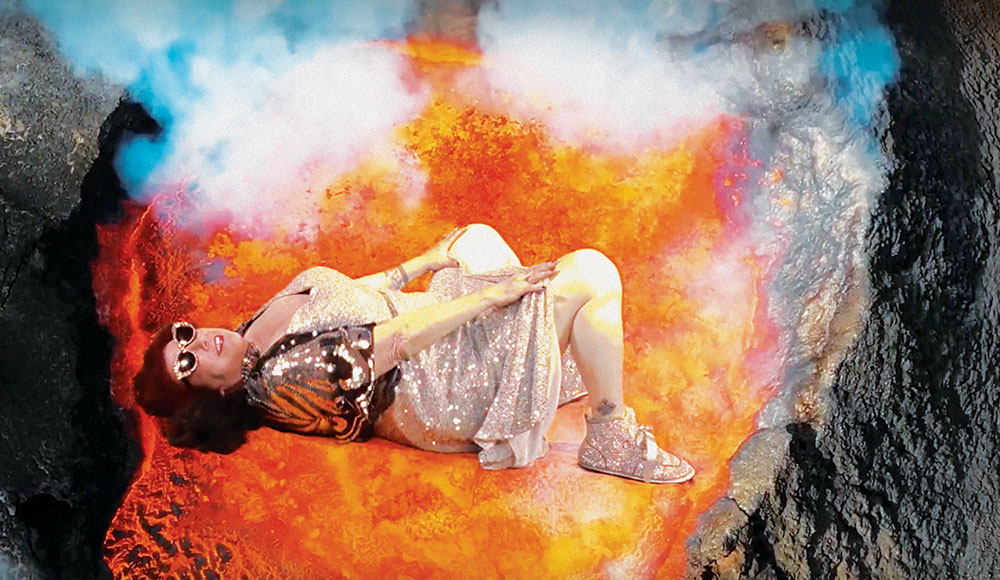Any time a subject that is heavy, serious or traumatic is approached with humor it’s risky.
In their latest film, the third in an Ecosexual/Environmental trilogy, Santa Cruz filmmakers Beth Stephens and Annie Sprinkle boldly take on that risk…and then some.
Even the film’s title, Playing with Fire: An Ecosexual Emergency, could be triggering, particularly in our community, since it’s focused on, well, fire, and prominently features scenes and storytelling about the tragic, devastating, life-altering CZU fire in Boulder Creek.
But risk-taking comes naturally to these two artists who have spent nearly five decades expanding cultural conversations about sexuality: Sprinkle as a trailblazing sex-positive feminist, performance artist, former porn star, writer, speaker and educator; Stephens as a professor of art at UC Santa Cruz, award-winning filmmaker and performance artist, whose work explores sexuality, gender and the environment.
The two have been a couple and creative collaborators for more than 20 years. Together, they co-founded the Ecosexual movement, creating provocative films, performances and public rituals.
If, like me, you were not previously familiar with the word “Ecosexual”—a term Stephens and Sprinkle are credited with coining—let’s pause quickly for a definition. Ecosexual means that one treats the Earth as a lover, rather than a mother. This is intended to shift our environmental mindset away from a sense of duty or even guilt (“we must protect Mother Earth”) to one of intimacy, desire, eroticism and pleasure (“we want to love, cherish and celebrate the Earth”).
Ecosexuality is completely new territory to me. Fire is not.
While we did not lose our home, business, animals or property like so many did, my family was seriously threatened and twice evacuated during the gigantic SCU fire, which occurred at the same time as the smaller CZU fire—August 2020, right at the height of Covid. The sky turned orange, my teenage daughter turned gray, and for a long time I was a grisly shade somewhere in between.
So I felt deeply conflicted watching the film and was even more nervous about interviewing Stephens and Sprinkle.
I wanted to keep a growth mindset, be willing to learn and stay respectful of their art and belief system, but I wondered how they wanted audiences to think and feel about the content, given the irreverent way the story is told. Without any spoilers, let’s just say there are several scenes (goats seemingly texting; a white Peacock named Albert that narrates; funky costumes and fire rituals) that seem to be making light of fire or treating it in a cheeky, goofy or irreverent way, which made me squirm.
With these early impressions of the film, all this new terminology and my own “fire baggage,” it seemed like the interview would be tricky. But Stephens and Sprinkle—relatable, charming, warm and easygoing—immediately put me at ease and allowed me to appreciate their point of view.
“Our neighbors suffered,” Stephens says. “We suffered too, but we were spared. So we really were trying to respond to the environmental damage and opportunity that the fire caused, but also trying to understand the bigger picture of what this meant for the future.”
Just like all of us, Stephens and Sprinkle struggled through the fire. But their response, their learnings, their art and how they changed, were poured into the creation of this film. “This film changed us,” Stephens says. “It really made us realize that we’re just a small part of a much bigger system.”
“That’s really where we are coming from,” Sprinkle adds. “It’s an environmental issue. But it’s also a social issue. This is not something that’s going to go away.”
This is a genre of film that Stephens and Sprinkle also defined. They created the first queer environmental documentary feature film, and this third chapter, “Playing with Fire,” is considered their most epic and daring yet—“fusing art, activism and intimate storytelling in a touching journey through crisis, change and renewal,” according to the promotional materials, which go on to say “when a firestorm rips through their redwood forest home, Stephens and Sprinkle emerge with a powerful message of love, resilience, and ecological hope, guided by a relationship with their magical peacock.”
And all that humor and irreverence that left me feeling somewhat confused? Yea, it was all completely intentional. Comedy has always helped us cope and this film respects that tradition.
For example, Stephens explains the talking peacock this way: “Our hearts were with our neighbors, our worries were with our house. But the entity that we really, really were the most worried about was this damn peacock named Albert. We realized that he symbolized so many great things about Boulder Creek. He became a metaphor for hope. It was clear to us that there were these things that were larger than us, more important than us.” So, naturally, Albert needed a speaking role in the film.
Sprinkle puts it this way: “We’ve always said life is art. Any kind of so-called problems, we try to see as opportunities.” And in one of the best sound bites of our entire conversation, she says, “We try to make problems sexy and fun, to lubricate ourselves through the hard stuff.”
Stephens agrees: “We turn all kinds of things, whatever’s going on in our life, into art.”
The art that the two created right here in Santa Cruz is getting recognition on a global stage. Stephens rattles off so many upcoming film festivals at which it will be screened that I lose track. The duo’s films have been screened at film festivals around the world for years. “But this feels like our home festival.” In fact, all three of the pair’s films have been screened at the Santa Cruz Film Festival.
“We learned a lot from the first two films,” Sprinkle says. “And I think in this film, the difference is, we have more ecosystemic knowledge. I think it’s our most mature film because we are more mature. And we’ve learned. I think our film shows the complexity of today’s times. I’d like to think this is very much a film for the moment.”
The film took four years to complete. Partly because filmmaking, which sounds so glamorous, is actually an arduous, time-consuming process, fraught with challenges big and small. One has to move fluidly amidst administrivia and niggling details like rights, permissions, budgets and access without losing sight of big-idea creativity, innovation, uniqueness and cinematic brilliance.
As if that weren’t hard enough, during the film’s creation Sprinkle was confronted with recurring breast cancer, which obviously meant the whole project was recalibrated amidst larger priorities.
But as I was quickly learning, even a subject like breast cancer isn’t off limits to the couples’ funny bone. “We’re making art about breast cancer,” Stephens says. “We have an exhibition coming up in San Francisco. But yea, we had to drop the ball on the film for a while because we had to take care of Annie’s breasts,” which she then lovingly but jokingly referred to as “a national treasure.”
The two are not oblivious to the fact that “playing with fire”—using humor, being saucy and mischievous while telling this tough story—could, to continue the metaphor, leave some feeling burned. Those who are deep in grief, trauma, fear or loss may not be emotionally available for that approach. In fact, they’ve gotten that feedback directly.
“Sometimes people get very angry at the way we use humor,” Sprinkle says. “We’ve been very roundly criticized for not being serious. I think that’s a really good critique for some people. I say a ‘spoonful of humor, some medicine go down’…for some of us, but it’s not for everybody.”
“We use humor to counteract the heaviness of the issues of the day because we’re seeing in real time how people are falling apart under the burden of what is going on in our society right now,” Stephens says. “It doesn’t matter which side you’re on, you know? People are falling apart because it’s so heavy. And we try to create a space of play or a space of sensuality where we are not letting this stuff get us down. We’re trying to create a space to breathe so that we can have some calmness. I also feel that humor is a really powerful form of resistance and self-preservation.”
Playing With Fire had its sold-out premiere in June at Frameline Film Festival, the world’s longest-running LGBTQ+ film festival. The critical acclaim, press coverage and overall reception were “really great,” Stephens says, “and not just from our fan club. But people who do know us feel like this is the best piece, the best film that we’ve done so far.”
The Santa Cruz Film Festival will be only the second time Playing With Fire has been screened in front of a large public audience. “We had the Frameline premiere and now Santa Cruz is the next stop. It is a spanking new baby,” Stephens says.
So what are their hopes and dreams for this bouncing bundle of joy?
“I want to highlight the generosity of the community,” Stephens says. “There was so much generosity in contributing to this film. It was really moving. And some of those people lost their homes. As a community, we all pulled together in beautiful, beautiful ways. The community worked together through the good of the greater whole, rather than being mired in individualism. And it is really important to say that this is our love song to the Santa Cruz Mountains. The people and the animals and the nature and all of it—the ecosystem. And it’s fire. And we also clearly hope it reflects our love for the mountains, for the trees and for the people there.”
Sprinkle adds, “We’re creating something that we hope is provocative, informative, complex, well done. Those are things we’re aiming for, not necessarily the biggest audience.”
Stephens can’t resist adding, “And I also just really want to say, I’m grateful to the Santa Cruz Film Festival because this is the only festival that’s shown all three of our films at this point.”
As the featured Local Spotlight film, Playing With Fire: An Ecosexual Emergency screens on Sunday, Oct 12 at 4:30pm at the Colligan Theater, followed by a Q&A with directors Beth Stephens and Annie Sprinkle. Get tickets here.












